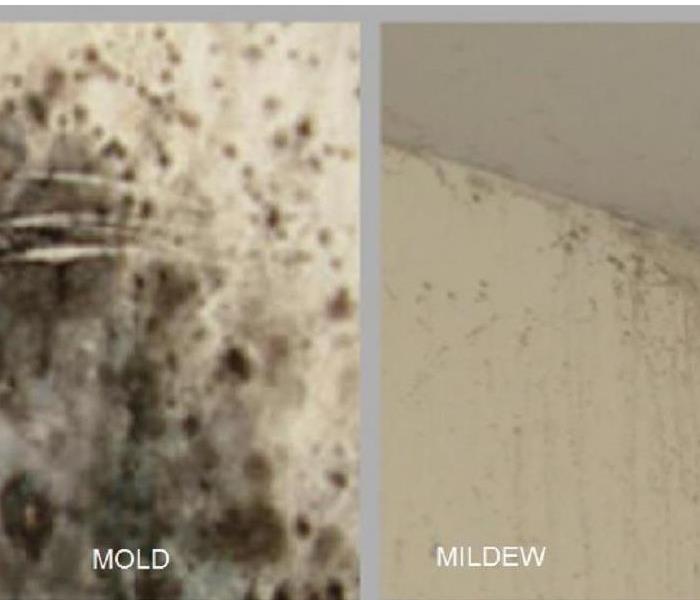Is It Mold Or Mildew?
3/2/2018 (Permalink)
Is It Mildew Or Mold?
Plain and simple, mildew and mold are fungi. Fungi can live in many different types of habitats such as in soil, on vegetation, and on surfaces exposed to moist conditions like a wall or ceiling after flood damage. Fungi reproduce by spores and quickly can spread.
What is mildew? Mildew is mold in its early stage and often the term is used interchangeably with the word mold. That whitish-gray, powdery substance sometimes seen on the leaves of a plant is mildew. Mildew is a surface fungi that grows on organic material like plants and food as well as wood or fibrous items like:
- Drywall
- Insulation
- Cardboard/paperboard
- Wallpaper
- Fabric
How is it different from Mold? Mold ranges in color from green to gray, brownish and black. It may appear fuzzy, flat or even slimy. Green slimy mold may develop in the damp, shady areas of decks and even vinyl siding, while indoors, mold can develop on grout, tile and other surfaces found in and around bathrooms and other areas with high humidity and inadequate ventilation.
Differences in the Effects of Mold and Mildew
Both mold and mildew need to be taken care of in a quick and efficient manner as they can cause a lot of trouble over time:
- Mildewusually affects plants and crops.
- Mold can result in considerable structural damage when left unattended for a long time.
What is Mold and how many types are there?
Although the number of mold species that can live indoors exceeds 10,000, the most household molds belong to one of the following five types:
- Alternaria grows on walls, in showers, around windows, under sinks and in various other damp places.
- Aspergillus is the most common type of mold found indoors. It can look grey, brown, yellow, green, white, or black. Aspergillus mold usually grows on walls, insulation, paper products, and clothing.
- Cladosporium can grow in cool areas. It usually appears on fabrics, such as carpets or curtains, and on wood surfaces, like cabinets and floorboards.
- Penicillium can be found on various materials that have been in contact with water, including carpeting, wallpaper, insulation, and mattresses. It looks blue or green and produces strong musty odors.
- Stachybotrys chartarum, often referred to as “black mold” because of its color, is the most dangerous kind of household mold.
How to Prevent Mold and Mildew
The most efficient way to prevent mold and mildew in your home is to keep all the areas dry and moisture-free. Maintain a humidity level of about 40-50% inside the house (a dehumidifier provides the most advantageous solution for ensuring appropriate indoor humidity), have your heating and cooling systems regularly inspected, keep air ducts clean and in good condition, ensure good air circulation inside the premises, fix any leaks in the bathroom, kitchen or other areas, etc. Remove any mildew-affected plants and weeds as soon as you notice them in order to prevent mildew infestation.
How to Clean Mold and Mildew
Mildew is a surface fungus that can be efficiently treated with a commercially available cleaner and a scrubbing brush. Just make sure you work in a well-ventilated area and wear a facial mask to prevent inhaling mildew spores, as well as to avoid breathing in fumes given off by the cleaning product you use. It is also advisable to put on rubber gloves in order to protect your hands both from the mildew and from the cleaning agent. Clean all the surrounding areas carefully as well, to ensure that all the fungi have been successfully removed.
Mold, on the other hand, attaches to the affected materials with microscopic filaments that penetrate beneath the surface. The mold spores spread very easily and can survive in extreme conditions, so they can quickly affect large areas of your property and result in permanent damage. Despite its characteristic musty smell, mold is only visible to the eye when the colonies start growing, so early detection and prevention is very difficult. DIY remedies are rarely efficient because the fungus usually grows in areas that are very difficult to access and to treat
The Need for Mold Remediation
Mold and mildew, if ignored, can cause long-term health issues and physical damage to a home or business. Mold found anywhere in a building, such as behind drywall, on insulation, around windows and along basement walls has developed because there is a moisture problem. To avoid further damage, it’s essential to locate and correct the source of the moisture and then remove all traces of mold. The safest and most efficient way to get rid of a mold problem is to call a mold remediation company. An experienced professional will come to your home to assess the situation and determine the type of mold or mildew in your property, as well as the extent of the damage. Then, the most appropriate actions will be taken to remove the harmful fungi and prevent its appearance in the near future. The experts will help ensure not only the safety of your living environment, but also your peace of mind.





 24/7 Emergency Service
24/7 Emergency Service
